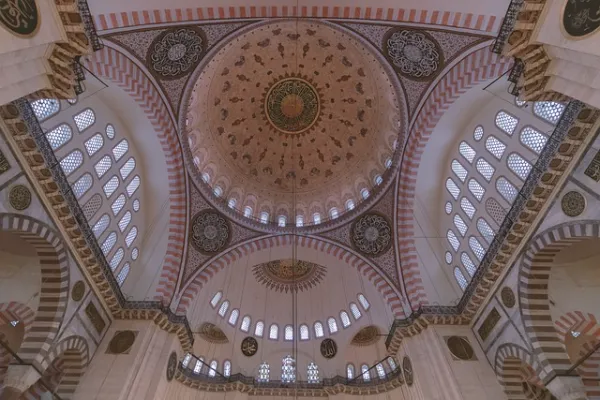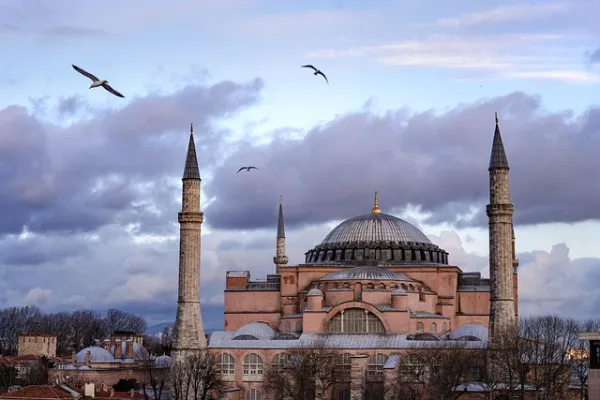Interesting Facts About Hagia Sophia

Hagia Sophia, known as Ayasofya in Turkish, is a wonder situated in Istanbul, Turkey. With a captivating past and numerous captivating details about its creation, evolution, and importance, this historic edifice has witnessed transformations over the years. Originally built as a cathedral, later repurposed as a mosque, and currently serving as a museum, Hagia Sophia stands tall as a representation of cultural diversity. Let’s delve into interesting facts about Hagia Sophia and unveil the mysteries that contribute to its enduring significance.
Table of Contents
- The Hagia Sophia was once the world’s largest cathedral
- Hagia Sophia has survived multiple earthquakes and invasions
- The Hagia Sophia has been both a Christian cathedral and an Islamic mosque
- The Hagia Sophia’s iconic dome was an architectural marvel of its time
- The Hagia Sophia is home to stunning mosaics and frescoes
- Hagia Sophia’s unique architectural style influenced buildings around the world
- The Hagia Sophia has been a UNESCO World Heritage site since 1985
The Hagia Sophia was once the world’s largest cathedral
The Hagia Sophia, situated in Istanbul, Turkey, was constructed in the 19th century. Held the title of the largest cathedral globally for almost a millennium. Initially serving as the church of the Byzantine Empire, it was later transformed into a mosque. Then it was repurposed as a museum in the 20th century. The architectural brilliance of Hagia Sophia showcases design elements, notably its grand dome, which stood as an engineering marvel during its era. Presently designated as a UNESCO World Heritage Site, it remains a historical monument of great significance.
Hagia Sophia has survived multiple earthquakes and invasions
Hagia Sophia, a landmark situated in Istanbul, Turkey, has endured earthquakes and invasions over its extensive past. Initially constructed as a cathedral in the century, Hagia Sophia has faced several seismic events that have challenged its structural stability. Despite these trials, the structure has remained upright thanks to its thoughtful design and robust construction.
Apart from calamities, Hagia Sophia has also confronted invasions over the ages, including sieges by various military forces and empires. The monument has been. Transformed into a mosque, then into a museum, mirroring the shifting political and religious dynamics of the area. Despite these occurrences, Hagia Sophia stands tall as a symbol of resilience and perseverance, showcasing the expertise and artistry of its creators.
In essence, Hagia Sophia’s resilience against earthquakes and invasions underscores its enduring fortitude and historical importance. Recognized as a UNESCO World Heritage Site, it continues to draw visitors from across the globe who come to appreciate its magnificence and marvel at its ability to endure through time.
The Hagia Sophia has been both a Christian cathedral and an Islamic mosque

Standing in Istanbul, Turkey, the Hagia Sophia isn’t just a building; it’s a captivating story carved in stone. This architectural marvel has witnessed centuries of history, transforming from a Christian cathedral in the 6th century to a mosque in the 15th, reflecting the region’s ever-changing religious and political landscape. Its journey began as a magnificent basilica under Emperor Justinian, holding the title of the world’s largest cathedral for nearly a millennium.
The Ottoman conquest brought a dramatic shift in 1453. Sultan Mehmed II converted the Hagia Sophia into a mosque, adding Islamic elements like minarets and calligraphy while veiling Christian artwork. It served as a pivotal mosque for nearly 500 years until the rise of the Turkish Republic in 1935. Mustafa Kemal Atatürk, the republic’s founder, saw it transformed into a museum, aiming to celebrate its universal significance rather than restrict it to a single faith.
However, 2020 marked a controversial turn when President Erdoğan’s decree reverted the Hagia Sophia back to a mosque. This decision, met with international criticism, adds another layer to the complex story of the structure. As a UNESCO World Heritage Site, its status raises concerns about balancing its historical and cultural value with its current religious purpose.
The Hagia Sophia is a testament to the intricate interplay of religion, politics, and culture throughout history. Its unique architectural blend and profound significance continue to captivate visitors worldwide, standing as a symbol of both Christian and Islamic heritage, forever intertwined.
The Hagia Sophia’s iconic dome was an architectural marvel of its time
In the 6th century, the Hagia Sophia’s dome defied gravity and expectations. With a staggering diameter of 31 meters, it was an architectural marvel, unprecedented in its size and scale.
But what made this feat possible? Innovation was key. The architects employed lightweight materials like hollow clay bricks, significantly reducing the overall weight. This ingenious technique allowed for a vast, open space without the burden of bulky support columns.
However, the dome’s immense weight required further support. Sturdy piers and arches, strategically built around the perimeter, acted as the structure’s backbone, distributing the load and ensuring the dome’s stability.
Adding to the dome’s brilliance was a row of windows at its base. These weren’t just for aesthetics; they bathed the interior in soft, natural light, illuminating the dome’s grandeur and creating an atmosphere of ethereal beauty within the church.
Centuries later, the Hagia Sophia’s dome continues to stand as a powerful testament to the ingenuity and skill of its creators. Its innovative design and engineering remain a source of awe and admiration, a true masterpiece of architectural prowess.
The Hagia Sophia is home to stunning mosaics and frescoes

Step into the Hagia Sophia, and you’re not just entering a building; you’re stepping into a beautiful tapestry of art. This Istanbul landmark stuns with its exquisite mosaics and frescoes, remnants of the Byzantine era, each a masterpiece in its own right.
Crafted from countless small, colored tiles called tesserae, the mosaics meticulously depict religious figures, ornate patterns, and captivating scenes from the Bible. These vibrant murals adorn the walls and ceilings, weaving a narrative that transports visitors centuries back in time.
But the artistic journey doesn’t end there. Alongside the mosaics, the Hagia Sophia boasts a collection of breathtaking frescoes. Painted directly onto the walls, these artworks showcase the remarkable skill of their creators. From religious themes to historical events, each scene is a testament to the artistic prowess of the Byzantine Empire.
Together, the mosaics and frescoes of the Hagia Sophia stand as a powerful testament to artistic heritage, serving as a timeless source of awe and inspiration for generations of visitors.
Hagia Sophia’s unique architectural style influenced buildings around the world
The Hagia Sophia, a jewel of architectural design in Istanbul, stands as a beacon of inspiration for countless structures across the globe. Its unique style, characterized by the awe-inspiring dome, vibrant mosaics, and innovative use of space, has left an indelible mark on architectural history.
The centerpiece of this marvel is undoubtedly its massive dome, a staggering 31 meters in diameter and reaching an impressive 55 meters high. This engineering feat, supported by a network of pendentives and semi-domes, has been echoed in iconic structures like the Dome of the Rock in Jerusalem and the Umayyad Mosque in Damascus.
Stepping inside, one is immediately captivated by the exquisite mosaics adorning the Hagia Sophia’s interior. These intricate works of art, depicting religious scenes, geometric patterns, and captivating designs, have served as inspiration for artists and architects worldwide. Their influence can be seen in the decorative elements of countless buildings, reflecting the enduring legacy of the Hagia Sophia’s artistic brilliance.
Beyond its visual beauty, the Hagia Sophia’s innovative use of space has profoundly impacted the design of religious buildings across cultures. The central dome, supported by massive arches and columns, has been a source of inspiration for churches, mosques, and other structures aiming to create a sense of spaciousness and grandeur. The building’s unique blend of Byzantine, Islamic, and Roman architectural traditions has served as a model for architects seeking to transcend cultural and religious boundaries, offering a testament to the unifying power of architectural innovation.
The Hagia Sophia has been a UNESCO World Heritage site since 1985
The Hagia Sophia, a jewel of Istanbul, isn’t just a building; it’s a living testament to history. Recognized as a UNESCO World Heritage site since 1985, this iconic landmark embodies cultural and historical significance that transcends its walls.
This prestigious designation underscores the international commitment to safeguarding the Hagia Sophia for future generations. It’s a powerful reminder of this architectural marvel’s enduring legacy, a symbol standing tall after witnessing centuries of transformation.
From its origins as a Christian cathedral to its time as a mosque and eventual conversion into a museum, Hagia Sophia has been a pivotal player in shaping Istanbul’s cultural and religious tapestry. Its innovative architectural design, featuring the awe-inspiring dome, served as inspiration for countless structures across the globe.
Today, the Hagia Sophia continues to captivate visitors, offering a glimpse into the past while standing as a symbol of unity and cultural exchange. Its inscription as a World Heritage site ensures its preservation, allowing future generations to witness the remarkable story etched in its very stones.